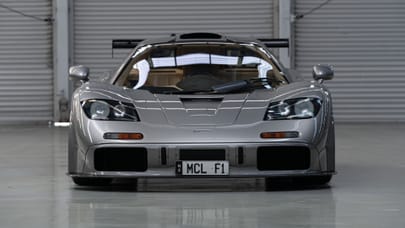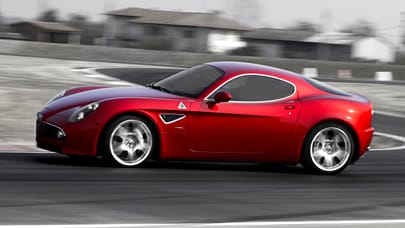
Top Gear's coolest racing cars: Ferrari's gorgeous 166MM Barchetta
Ferrari makes some of the world's most beautiful cars. This is one of them


Ferrari has produced more of the world’s most beautiful cars than anyone else. Discuss.
The company set the bar sky high pretty much from the off. Ferrari set up in business as Auto Avio Costruzioni in 1940, creating a tiny handful of cars as a precursor to the giant he and his company would become. That journey began properly in 1947, and victories as an independent manufacturer came remarkably quickly. The 166 won the Mille Miglia in 1948 piloted by Clemente Biondetti and Giuseppe Navone, and again in 1949, with Biondetti and Ettore Salani. (An ailing Tazio Nuvolari also agreed to race for Ferrari in 1948, but retired – ‘Cheer up, Tazio, the race will be yours next year,’ Enzo wrote to him. ‘Ferrari, at our age there aren’t many more days like this; remember it and try to enjoy it to the full, if you can,’ he replied. Biondetti, in awe at having defeated the famous Nuvolari, began his address at the award’s dinner, ‘Excuse me for having won…’)
Advertisement - Page continues below
Such feats from this nacent Italian car manufacturer were amazingly impressive, and inspired the 166 MM. Ferrari would anoint Pinin Farina his preferred creative partner in 1951, but until then a multiplicity of Italy’s famous carrozzeria were tasked with clothing the chassis’. Touring of Milan was renowned, not least for its lightweight ‘superleggera’ technique that artfully encased the 166’s tubular steel chassis in aluminium panels of breathtaking beauty and simplicity. From the distinctive egg-cate grille to its pert posterior, the 166 MM was a perfect evocation of the artisan’s skill. The car was done entirely by eye, initiated by Touring’s boss Felice Anderloni, and completed by his son Carlo following his father’s passing. It was powered by Giocchino Colombo’s magnificent V12, a 2.0-litre bored and stroked for duty in the 166, and with a consequent increase in power to 140bhp. No wonder Ferrari got himself on the radar: this was heady stuff back in the late 1940s.

But the 166 MM’s exalted place in the grand scheme of things is also attributable to the victory scored by Luigi Chinetti in the 1949 Le Mans 24 hours, the first to be held in the wake of WW II. Amazingly, he used the same car that had just won the Mille Miglia, following its purchase by British aristocrat and driver Lord Selsdon. Although details are strangely scant, it’s a fact that Chinetti drove the little Ferrari for 23 out of the 24 hours. (Some say that Selsdon drove the minimum necessary according to the rules, others that the rather louche English Lord was, erm, too refreshed to participate.)
Advertisement - Page continues below
So while the 166 MM is hugely significant in the overall Ferrari narrative, it’s nothing compared to the role played by the man who scored the first of Ferrari’s nine victories in the world’s most celebrated race – and in such singularly spectacular style, too. Chinetti was born in Varese, Italy in 1901. Aged just 16, he joined Alfa Romeo’s R&D department, which is where he first met Enzo Ferrari, at the time one of Alfa’s principal drivers. In 1925, Alfa Romeo despatched Chinetti to the French Grand Prix; this was one of the cornerstones of the then-new Formula One world championship, although the race itself was over-shadowed by the tragic demise of Antonio Ascari.

Chinetti elected to stay and work with Count Mario di Carobbio, Alfa Romeo’s man in France, and quickly established himself in the fast-developing automotive world. His first race was 1925’s Paris Six Hours; just six years later, he won Le Mans for the first time, in a privateer Alfa Romeo, defeating the works entry in the process. He came second in 1933 (losing out to Nuvolari, the driver Enzo Ferrari regarded as the greatest he ever knew) and won again in 1934. Shortly after that, he set up his own race team, Ecurie Bleue.
Chinetti was also a determined anti-fascist, and managed to use his new Equipe as a fig-leaf to enter the 1940 Indianapolis 500 and escape Europe – taking his friend and fellow driver René Dreyfus with him (Dreyfus was Jewish, so his need to leave was even more urgent).

Chinetti (pictured centre) became a US citizen in 1946, but hooked up with Enzo Ferrari on a visit to Modena that same year. It was he who persuaded Ferrari to enter Le Mans (the 166 also won the Targa Florio in 1949, making it the only car to win the Mille Miglia, Le Mans, and the Florio), but perhaps more importantly it was Chinetti who first turned Ferrari onto the opportunity the US market represented for his little sports car company. Luigi Chinetti Motors opened for business in Manhattan in April 1954, Ferrari’s first US distributor; four years later, he founded the North American Racing Team, whose blue and white livery soon became successful on the rapidly evolving 1950s and ’60s racing scene. Chinetti also proved himself an able talent-spotter, and the likes of Phil Hill – who would win Le Mans several times for Ferrari, as well as becoming F1 world champion for the Italians in 1961 – Richie Ginther and Dan Gurney all owe him a profound debt of gratitude. Because Ferrari was in dispute with the governing body at the time, John Surtees took the 1964 F1 championship in NART-liveried cars, a notable quirk in the Ferrari annals.
Chinetti’s life was a brilliant one, and well lived. He passed away in 1994, aged 93, having helped shape the destiny of one of the world’s most revered companies. Phil Hill remarked to the New York Times that he would be ‘remembered by many, many people who owe their successes to him’. As for the 166 MM, and the 24 hour race he won in it, its status as one of the coolest racing cars is irrefutable.
Trending this week
- Car Review
BMW 1 Series
- Top Gear's Top 9
Nine dreadful bits of 'homeware' made by carmakers







